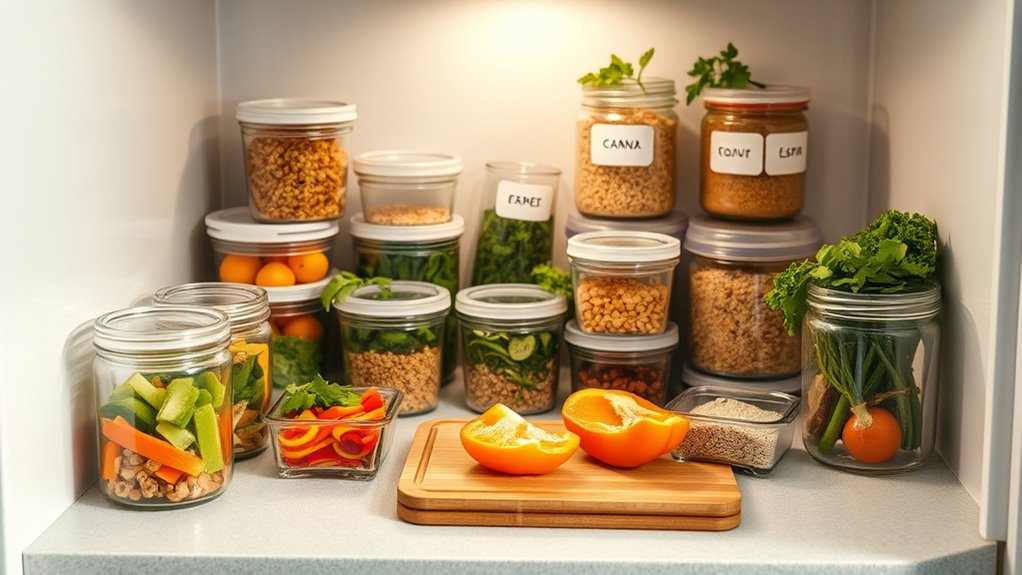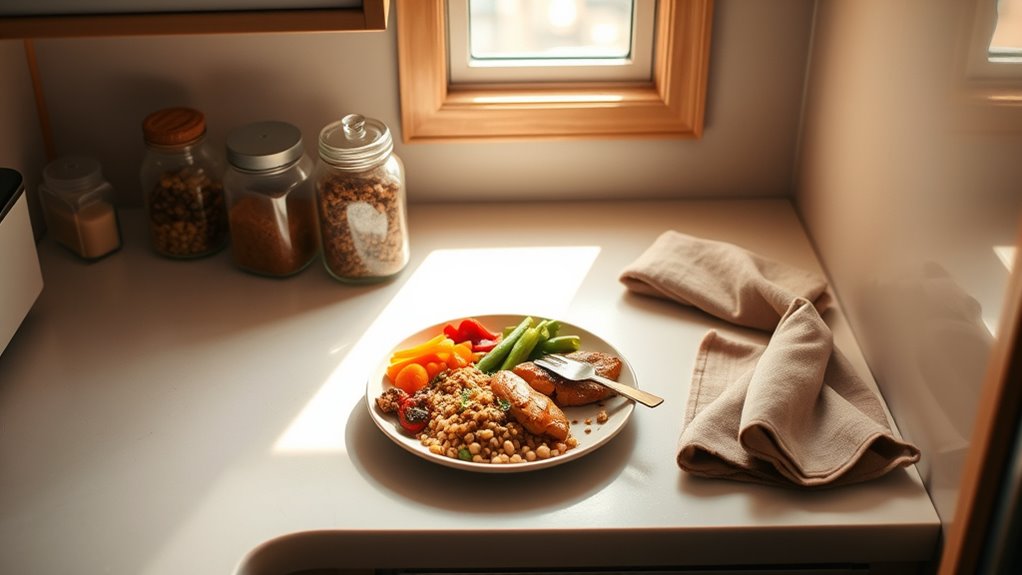To avoid food waste in your tiny kitchen, plan meals carefully by focusing on versatile staples and buying only what you’ll use each week. Portion food into single-serving containers to match your appetite and prevent leftovers from spoiling. Store leftovers properly in clear, labeled containers for quick access. Keep your space tidy by regularly cleaning to reduce pet hair and debris, which helps maintain hygiene. Exploring these strategies can make your kitchen more efficient—if you stay with us, you’ll discover even more helpful tips.
Key Takeaways
- Plan meals around versatile staples to minimize unused ingredients and reduce waste.
- Portion food into single-serving containers to match your appetite and prevent leftovers.
- Create detailed shopping lists based on weekly meal plans to avoid impulse buys and excess items.
- Use clear, labeled containers for leftovers to track freshness and encourage mindful consumption.
- Maintain a clean, pet-hair-free kitchen to promote hygiene and make meal prep more efficient.

Planning meals for one can be both simple and rewarding when you focus on efficiency and flexibility. When you’re cooking for yourself, it’s easy to fall into the trap of over-preparing or buying too much, which often leads to food waste. To avoid this, mastering portion control is essential. You want to buy only what you’ll realistically use, and prepare only what you can consume before it spoils. This means paying attention to serving sizes and cooking amounts that match your appetite. For example, instead of buying a large package of chicken breasts, opt for smaller cuts or pre-portioned options. This not only helps prevent leftovers from going bad but also keeps your grocery shopping focused and intentional.
Focus on portion control and buy only what you’ll use to minimize food waste.
When grocery shopping for one, it’s tempting to buy in bulk to save money, but larger quantities often don’t suit small kitchens or your weekly needs. To combat this, plan your meals around the ingredients you buy, sticking to versatile staples like rice, beans, or frozen vegetables that last longer and can be used in multiple dishes. Make a detailed shopping list based on your meal plan, which keeps you from impulse buys and reduces waste. Stick to your list, and buy only what you need for the week, considering portion control to prevent leftovers from piling up. This approach helps you shop smarter, saving money and space in your tiny kitchen.
Another tip is to prep your meals in small, manageable portions. When you cook, divide large batches into single-serving containers. This way, you always have ready-to-eat meals that fit your appetite, and you avoid reheating the same leftovers repeatedly, which can lead to spoilage. Pre-portioned meals also make it easier to grab a healthy lunch or dinner without having to cook every day, saving you time and reducing the temptation to order takeout.
Furthermore, using proper storage techniques can extend the shelf life of your food, helping you stick to your portion control and grocery shopping plans. Store leftovers in clear containers so you know exactly what you have, and label them with dates to keep track of freshness. This reduces the risk of eating spoiled food and encourages mindful consumption. Incorporating pet hair management strategies into your cleaning routine, such as regular vacuuming and grooming, can also help maintain a tidy kitchen environment by reducing fur and dander that could settle on food surfaces. By focusing on these simple strategies—portion control, thoughtful grocery shopping, proper storage, and maintaining a clean space—you can enjoy a well-organized, waste-free kitchen that makes meal planning for one both efficient and enjoyable.
Frequently Asked Questions
How Can I Store Leftovers Efficiently in a Small Fridge?
To store leftovers efficiently in a small fridge, you should focus on compact storage and smart container solutions. Use stackable, airtight containers to maximize space and keep food fresh longer. Label each container with dates to track freshness, and group similar items together. By organizing leftovers this way, you minimize clutter, prevent waste, and make it easier to find what you need quickly, keeping your tiny kitchen tidy and functional.
What Are Quick Meal Ideas for Busy Weekdays?
Did you know that quick meals can save you up to 30 minutes daily? For busy weekdays, focus on simple meal prep and versatile snack ideas. Think overnight oats, salads, or wraps that you can prepare ahead. Keep healthy snacks like nuts or fruit handy to curb hunger. These strategies help you eat well without wasting time or food, making your week smoother and more efficient.
How Do I Select Versatile Ingredients for Limited Space?
When choosing ingredients for limited space, focus on multi-use ingredients that offer flavor versatility. You want items like eggs, tomatoes, or spinach, which can be used in various dishes, saving space and reducing waste. Pick ingredients that can be cooked in multiple ways, so you can create different meals without clutter. This way, your tiny kitchen stays efficient, and your meals stay exciting and adaptable.
Are Frozen Foods a Good Option for Tiny Kitchens?
You might think frozen foods are a hassle, but they’re actually great for tiny kitchens. They make meal prep easier and help with portion control, so you don’t end up with wasted leftovers. Frozen ingredients last longer, saving space and reducing waste. Plus, they’re quick to cook, making your meal planning more efficient. So, yes—frozen foods are a smart choice for managing a small kitchen effectively.
How Can I Prevent Spoilage of Fresh Produce Quickly?
To prevent spoilage of fresh produce, you should use proper preservation techniques like storing items in the right temperature and humidity conditions. Keep an eye on spoilage indicators like mold, wilting, or off smells. Use airtight containers or produce-specific storage to extend freshness. Regularly check your fruits and vegetables, and plan to consume items before they show signs of spoilage, helping you minimize waste and enjoy your fresh produce longer.
Conclusion
By mastering meal planning in your tiny kitchen, you become the artist of your own culinary canvas—each ingredient a brushstroke, every meal a masterpiece. With thoughtful prep and smart shopping, you turn cluttered chaos into a symphony of flavors, avoiding waste like a skilled gardener pruning excess to let your pantry flourish. Embrace these habits, and watch your small space bloom with fresh, delicious meals—proof that even the tiniest kitchens can hold endless possibilities.









